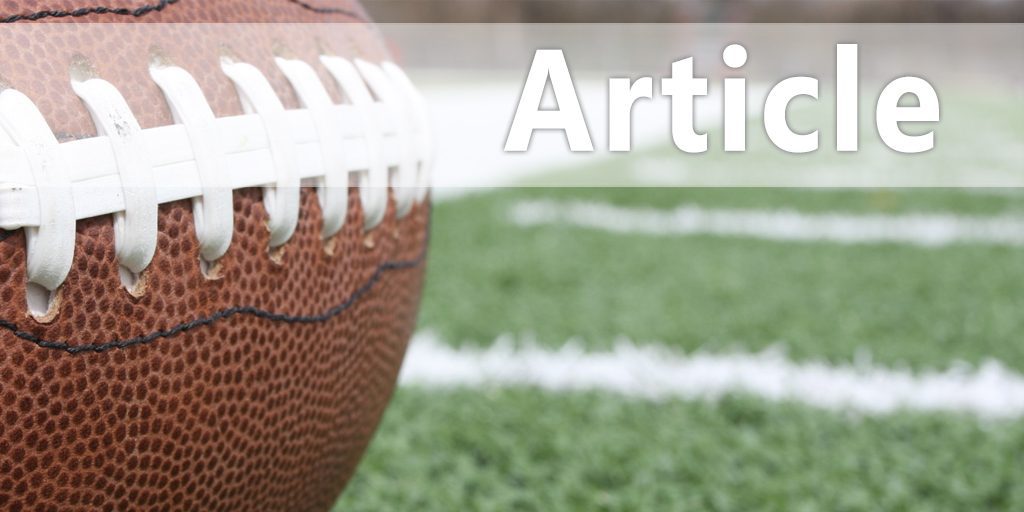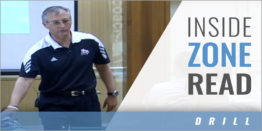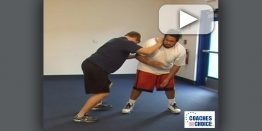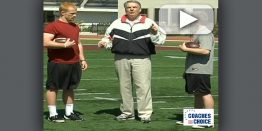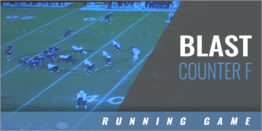| Defending Specific Wing-T-Style Offenses
I am going to show you a film clip of a few plays of a team that has been on our schedule for several years. This offense hurt our defense when we first saw it. Our kids were confused on defense. As a staff, we spend a lot of time trying to defend this offense. It did not come overnight. The first two times we faced that offense we did not play very well. No coach likes to lose. It does not matter the level you are coaching, you do not like to lose. You will see the coach on the other team did a great job with his offense. I want to point out a few things in the film that I hope will help you become a better defensive coach. When we first faced this offense, we had a lot of long plays against us and a lot of long touchdowns. The offense is similar to the teams that used to run the double wing offense 10 or 12 years ago. They ran a lot of misdirection plays against us. This was confusing for our high school football players. I want you to count how many plays they ran that looked like wing-T plays. Count how many plays were successful because of missed tackles. Twenty-five years ago, I had an All-American player that Coach Jimmy Johnson was recruiting at the University of Miami. I went down to watch them practice. I came back convinced we were going to run the 4-3 defense. That was a long time ago. I saw things they did that I could not believe. If you can't tackle, you are not going to win many games. If the players do not play technique, you are not going to win. Winning and losing still comes down to the team that plays the best techniques. Some coaches get carried away with X's and O's. That is not the answer. Let me get back to the film. How many of these plays looked like the wing-T plays? We got tired of getting beat by those plays. Most of the pass plays they ran were play-action passes. They tried to beat us deep. We got together as a staff and decided we were going to come up with a defense to stop this offense. Here is what we did on defense. There is so much technology available today you can learn from others. We went to a lot of clinics and got a lot of videos on this offense. We compiled everything we could find on the offense. We visited other high schools in Florida and studied what they did on the wing-T. You cannot stop an offense if you do not know how to run the offense. If you know how the offense works, you have a better chance of stopping it. After going to the high schools, I went to visit college coaches. I showed them some of the film and asked how they would defend this offense. I went to several colleges and not one of them turned me down as far as spending time talking about this offense. That is one of the most wonderful things about being a coach. No one turned me down and I talked with a ton of coaches. What I am trying to tell you is this. We took all of those ideas and formulated our own ideas on how to stop that offense. The first school I coached at, we were a big school with 3,300 students. The economy of Florida was falling apart. This last year we only had 1,700 students. Our enrollment in Orlando schools is decreasing every year. I was a head coach at Dr. Phillips High School for 11 years and I had six All-American players. I had three All-American offensive linemen. One of them is an All-American at The Ohio State University now. All of those linemen were 6'5" and over 300 pounds. They were great football players. We do not have that type of player today. This year we played with a noseguard that was 5'10" and 175 pounds. We are playing with players that are smaller, but we are playing with kids that can run. We do have some speed. I visited with Dave Wannstedt and Butch Davis when they coached at Miami. I asked Dave to tell me about the 4-3 defense. This is what he told me. He said this is what defense is all about: You practice defense differently than you do offense. The players have to be determined all of the time. If they do not want to be determined and focused, they can get off the field. In college, that is easier said than done. At times in high school, you have to get the players to meet you halfway. At least I do. We talk all of the time about techniques. In Florida, it is against the rules to have footballs on the fields in the off-season. You can do almost anything else, but if you throw out a football, someone is going to turn you in to the state. However, you can teach technique in the off-season. The most important thing Dave Wannstedt told me was to teach the players to be good tacklers. When it is said and done, running backs are going to break the line of scrimmage. Teams are going to drive the ball down the field if you do not tackle them. Can you tackle? Are you going to take the right pursuit angle to tackle the runner? The advice Dave and Butch gave me 25 years ago is still true. If you can't tackle, you are going to get beat. They told me you must build mental toughness through your defensive players. They talked about four things to teach on defense in order to build mental toughness: We do a tackling drill in the off-season. We do not use a football in the drill. We do not have football equipment on. Have you ever seen the big plastic Hula Hoops®? Some of the pro teams use them to work with their linemen. Warren Sapp played high school football for me. I was visiting him when he was playing with the Tampa Bay Buccaneers. They had these big Hula Hoops lying on the ground. The defensive linemen would do the figure eight through the Hula Hoops. We use ropes instead of the Hula Hoops because the ropes are cheaper. I can make the circle as big as I want or as small as I want it. We put flags on the players. We put two players inside the circle. We have an offensive player and a defensive player. You blow the whistle and the drill starts. The offensive man cannot leave the circle until the defensive man has pulled all of the flags from the offensive man. You may ask what this teaches. How many times have you see a tackler go for the ball and miss the tackle because he overextended his body on the attempt to make contact. What does this drill teach the kid? It teaches him to stay on his feet and not to overextend. He wants to get next to the offensive man and grab his flag. The drill takes 30 seconds. We do it twice a day and twice a week in the off-season. Kids love the drills. We have not had a player hurt in this drill since we put it into our program. I do not allow the players to wear the gloves that linemen wear. The offensive man has to stay inside the circle. The defensive player cannot quit until he gets all of the flags. We may use three flags on the offensive man. We can put two on the sides and one in the back of the offensive man. The offensive man is trying to run away from the defensive man. This teaches the defensive man to stay on his feet. He does not want to overextend on the drill. We do not allow the offensive player to use his hands in the drill. All he can do is run around inside the circle. If you run this drill in the off-season, it will help them become better tacklers in the fall. I picked this drill up at a clinic in Atlanta. I was speaking at a clinic and this youth league coach was giving an on-the-field type lecture. I saw him do the drill and decided to put the drill into our program. We prefer to do this drill at the end of practice. I went to coach at Edgewater High School 11 years ago. We only had two varsity players returning from the previous team. In our first meeting, this is what I told them. In the off-season workouts, the players are going to hold the other players accountable. Over the years, I have never had a problem doing that. • Players hold players accountable. We hold our players accountable for their teammates. We tell them all of the time to check their egos at the door. The only thing that is important is how successful your unit is going to be. How many defensive linemen are going to come to the workout? You nominate players to be in charge of the groups. You can go around and ask the leaders of the groups, "How many players are missing from practice today?" If the player tells me he does not know, I let him know that it is his fault and it is my fault, as well. It is my fault because I did not check on him at lunchtime. "It is also your fault for not having him here. I guess you do not want to have a good team." This is the difference in football and any other sport. I am not against other sports. I want my players to be around other players. I want them to play other sports. I want them with the other coaches because I believe coaches are good people. They have to be accountable if they are going to be there. At our school, you cannot play on defense if you are not willing to commit to our program. I do not care how big you are; if you are not committed, you can't play defense if you are not committed to our program. If they play defense for us we may buy them a special T-shirt, award them with a decal on their helmet, or something to reward the defensive players that are committed. Former Auburn University Coach Pat Dye told me to reward the different units. He said,"Offensive linemen must be first." They need to be first in the cafeteria line and first in all of the lines where football players are involved. The offensive linemen do not get the recognition they are due. The coaching staff must reward them as much as possible. The last point we stress on defense is the fact that size is not a factor. It is a matter of commitment and determination. How well can you tackle? How well can you play your technique? Those are the only things we ask of our kids. FOCUS ON TECHNIQUE We focus on these six drills we got from Jimmy Johnson. We do these drills in our practice three days a week. We dress out in pads every day. Some coaches tell me they do not hit during the season. We are going to do those six drills three days a week. Everyone knows what the board drill is. This drill is aggression and determination. We do that drill three days a week. The reason we do the pass rush drill is because everyone in Florida is running a spread offense. Teams are throwing the ball 30 to 35 times a game. If you go to the playoffs, it gets worse. I think the players of south Florida are faster than kids are in central Florida. What is the best way to defend the pass? Sack the quarterback! Therefore, we work on the pass rush three days a week. The 7-on-7 drill is the best drill Jimmy Johnson and Butch Davis taught me 25 years ago. I coached an offensive lineman at Evans High School in Orlando that was a first-round NFL draft choice. Leon Searcy was the eleventh pick in the NFL draft in 1992 out of the University of Miami. Leon Searcy and Russell Maryland would go against each other two or three times a week at the University of Miami. Russell Maryland was the number one NFL pick in the 1991 draft. These players were all NFL players. All of the Miami players took part in this drill. Here was the key to the drill. No one took a man to the ground. No one could block or tackle below the waist. We all know if your best players get hurt, you are not going to be very good, especially in high school. The thing I remember about that drill at Miami is that Jimmy Johnson had two whistles on plays. They lined up in the 4-3 defense and they worked against the I formation plays against the defense. One whistle was for everyone to stop, and the second whistle was for the ballcarrier to stop. It did not matter if the back was still running, he had to continue until the second whistle blew. I am sure a lot of you use the press coverage drill. We use it because we play press coverages. We play man coverage. I picked this up from Howard Schnellenberger when he was the head coach at Miami. He only played his corners on press coverage. We play press coverage where we play cover zero. We practice cover zero half line. We put two receivers to one side and cover them with press coverage. As soon as the play is over for that first group, the other side of the line comes up and gets ready to go and we work on press coverage on that side of the ball. We did this as a live drill. The only thing that was not live was that we did not allow tackling to the ground. You can't teach press coverage unless you do it live. During the off-season, we do the pursuit drills. We do not run sprints in our program. I never have used wind sprints in my program. The offensive and defensive linemen push my truck around the track at school. I cannot bring a sled on our game field because that is where we practice. We do our sled work on the track with my truck and we do it at the end of practice. I hate that we can't put a sled on our field. We have to improvise. The defensive backs and receivers and all other players are in pursuit drills. We set the cones up on the sideline and the defensive players must take the proper angle to run the ballcarrier down. I am sure all of you know the drill. The blind tackling drill I picked up from a youth football coach. There are a ton of tackling drills, but we try to do this drill three days a week. We hang three canvas type tarps over the goalpost. Eachtarp has a hook that we secure at the top of the crossbar. We divide the linebackers on each side of the goalpost. One line is going to be the ballcarrier, and the other side is going to tackle the man with the ball. We have the three tarps, with a little room between each tarp. We give a snap count and the ballcarrier tries to score. The defense does not know where the ball is coming from. It teaches the defenders not to overextend on tackling. They have to be in a good football position and find the ball. The man with the ball can go through any of the holes or outside of the holes under the goalpost. I believe this drill helps us in tackling in a game. I want to show you four formations. You do not have to call the formations the way we call them. We lined up the defense and we gave all of the backs and receivers a name. We call a formation with two tight ends and a wing and two backs in the backfield a tight formation (Diagram #1). We started researching this offense and we found the tight end was usually on the left side of the formation. In the tight formation, the line is unbalanced. They had a wingback one yard outside the end and one yard off the line. We called the second back inside between the two tackles the "sniffer back." All he is from that position is another guard. They had a quarterback and a tailback in the traditional spots in the backfield. 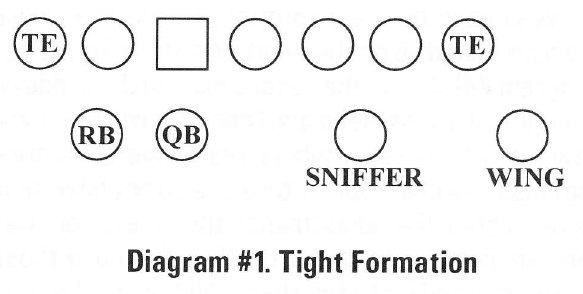 The next formation we call a "pro look." They have split one end and moved the wingback to the other side of the formation (Diagram #2).  We called the next formation "wide" (Diagram #3). It was the same situation with the tight end. The second man on the line from the inside was not a tight end. The first year we played them, I had a good strong safety. He covered that inside man on the line on passing situations. He spent the entire first quarter covering a player that was ineligible. I know players make mistakes, and I can assure you coaches make mistakes. We called that formation wide. 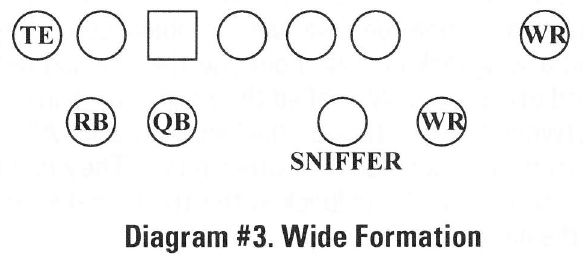 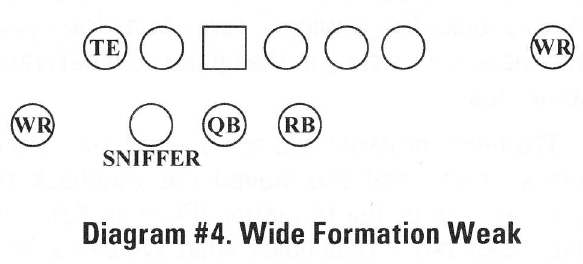 • Pass plays are deep routes, crossing patterns, play-action. • Pullers are looking for easy kick-outs. • Calculate the sniffer. We wanted to prevent the offense from completing the long passes on us. We found that most of the deep routes were on first down. This was especially true if there was a turnover. We found out from the computer program if we turned the ball over, they were coming with a trick play or a deep passing route. We had to make sure our players were aware of this before they got on the field. The pulling players, guards, ends, or the sniffer back were looking for the easy kick-outs. What did this offense remind you of? The wing-T offense. It is the old Buck sweep play where they are looking for the easy kick-out block. The third point we researched was the number of times the sniffer back was involved in the blocking scheme. How many times did the sniffer back take you to the point of attack? Against this team, it was almost all of the time. He was leading us to where the ball was going. FOUR BASIC ADJUSTMENTS We decided we would play man coverage against this team. That is our cover zero. When we play this team, we tell our players not to get caught peeking into the backfield. We were playing against a good football team and we were against a good coach. He knows what he is doing. We tell the secondary they do not have the ball. They have a man on defense and they must stay with their man. We tell the defenders to make the ball bounce and not to give up the vertical creases. We do not want the runners busting through a seam and getting into the secondary. We want to make the play bounce. The last point the computer told us was what we could expect the offense to do against us. We checked their tendencies and learned a great deal about what they were trying to accomplish against us. Here is one of the best plays they ran against us. At times, they would down block, kick out with the sniffer, and pull the frontside guard up in the hole. That looked like the Buck sweep to me. That is the wing-T Buck sweep play (Diagram #5). They also zone blocked the play where everyone on the line used a reach block, and they tried to outrun us to the corner. 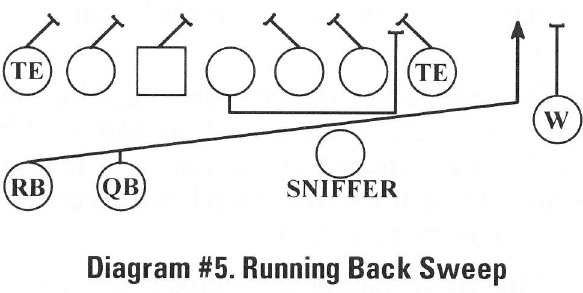 The next play was their best play. It is the wingback counter play out of the same alignment (Diagram #6). They used a handoff to the wingback, and they handed the ball to him coming behind the running back. Those were complementary plays. They had a play-action pass off this play as well. They faked the sweep and threw the deep ball. They faked the counter and threw the deep ball.  Another thing the offense did was to pull the tight end on the counter play. They pulled the guard, the sniffer, and the tight end on the wingback counter. They pull all three of them because that is their best play. The wing-T ran the same type play; when they ran the Buck sweep they ran the counter with the inside handoff to the wingback. This is the same play. They ran a quarterback counter play as well (Diagram #7). The quarterback can run the play inside the end, or he can run the play outside. The quarterback does a complete spin on the play. He spins, and turns, and finds his hole. 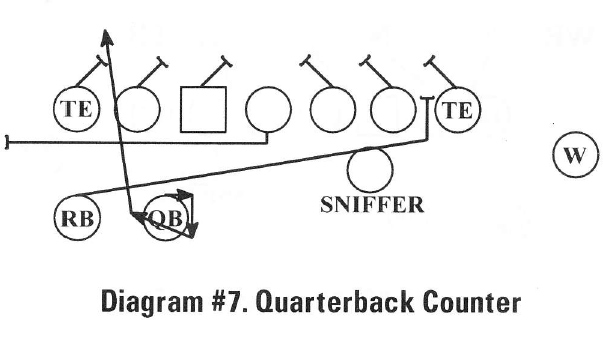 Those are the four main plays and the play- action passes that we decided to concentrate on stopping. We wanted to take those four plays away from them and force them to run something else. At times, that can be easier said than done, but that was our game plan. 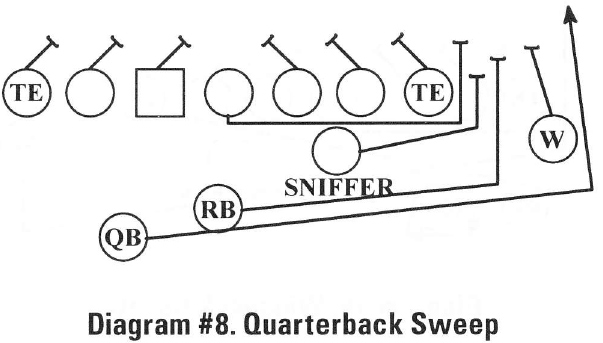 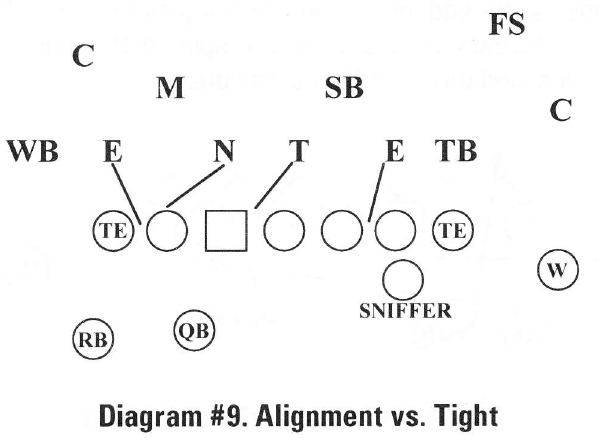 We call our two ends the Will backer and the tight backer. We flip-flop the linebackers. The reason is because the techniques are easier to teach. The tight backer lines up on top of the tight end. He is not going to let that tight end release down inside. He must fight the tight end and keep him from using the reach block. On the weakside, the end was uncovered. We did play the Will backer on the line most of the time. That is how we lined up to defend the tight formation. We told the weak backer if the ball goes away from him, he wants to stay on the line. If the ball comes to him, he wants to fight the tight end. We attack the pulling guards. Do not run up the field. Do not get kicked out of the hole. We want him to force everything inside to the Mike backer, who is our best player. We named one linebacker the sniffer backer. He had to cover the sniffer back. If the sniffer ran a pass route, the sniffer backer took him man-to-man. He covered the sniffer back on all plays. The Mike backer has the running back. He is our best football player. He plays more like a safety man. He is athletic and he can run. He is fast and he loves to hit. If we could keep him unblocked, he would make the play for us. If the sniffer backer keys through the guard to the sniffer back and sees the guard pulling, he calls out, "Pull, pull, pull" to the Mike linebacker. That means they are running the counter play. That is the reason we called the linebacker the sniffer backer. It was easy for the secondary because they were playing man coverage. They did not want to get caught peeking in the backfield. We are playing cover zero. Against the pro set, the corner had the #1 receiver from the outside to the inside (Diagram #10). The free safety has the #2 receiver to the inside. If the #2 man inside is not eligible, he could be a free safety. If the free safety lined up on the #2 man inside on the line of scrimmage, he was covering the wrong man. That man was not eligible. We want to help the free safety to cover the correct receiver. If we saw he was keying the wrong man, we called out from the sideline, "Tiger, tiger, tiger." He would have to go over on the other side and find the #2 receiver.  Against the wide formation, we played the corner on the strongside deeper than the shortside of the formation (Diagram #11). The split end on that side was their best athlete. We played press coverage on the backside. 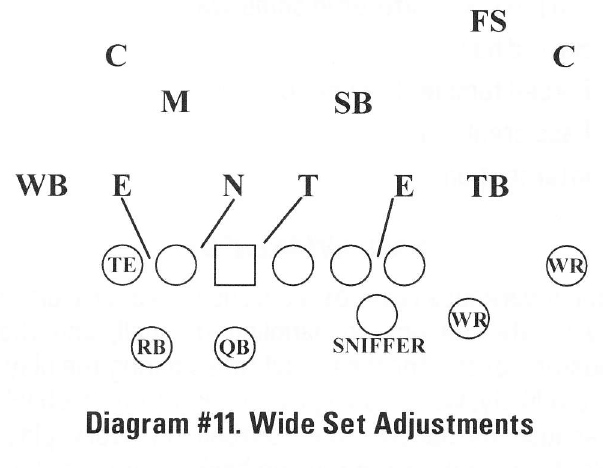 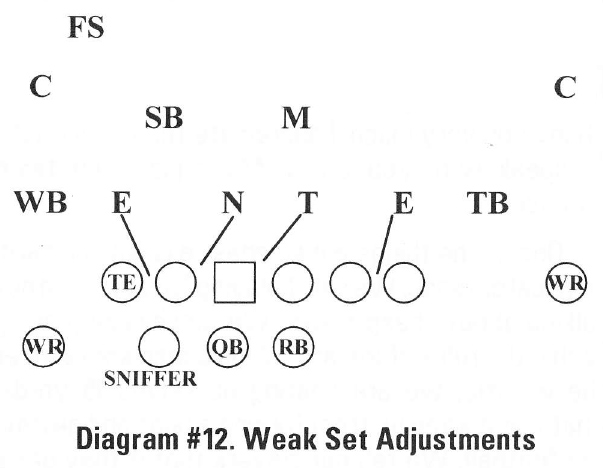 If I touched on something you are interested in knowing more about, feel free to contact me. Thank you. |
